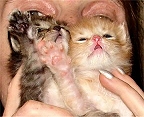Declawing is something that should only be considered in cases of EXTREME behavioral problems. Cats use their claws to exercise, play, stretch, climb, hunt and mark their territory. Although your cat might use your hands or furniture for these activities, declawing is NOT the answer and there are many other ways to guide your cat to healthy claw activity.
The declawing operation itself is the human equivalent of removing the first joint of all your fingers. Many vets feel that the lack of these joints impairs the cat's balance and can cause weakness from muscular disease. Declawing also makes a cat feel defenseless and can affect their personality, making them skittish or nervous biters. In rescue work, we see many declawed cats that have been given up by their owners. Why? Because these cats still had behavioral problems that were worsened by not having their claws. So, if you are adamant about declawing your new cat, why not consider adopting a cat which has already been declawed?
Take it from an expert. Dr. Nicholas Dodman, author of The Cat Who Cried For Help, offers this perspective on the procedure:"Declawing involves more than simply trimming a cat's nails to the quick; it actually involves amputation of the tips of the digits, bones and all. The inhumanity of the procedure is clearly demonstrated by the nature of cats' recovery from anesthesia following the surgery. Unlike routine recoveries, including recovery from neutering surgeries, which are fairly peaceful, declawing surgery results in cats bouncing off the walls of the recovery cage because of excruciating pain. Cats that are more stoic huddle in the corner of the recovery cage, immobilized in a state of helplessness, presumably by the overwhelming pain. Declawing fits the dictionary definition of mutilation to a tee. Words such as deform, disfigure, disjoint, and dismember all apply to this surgery. Partial digital amputation is so horrible that it has been employed for torture of prisoners of war, and in veterinary medicine, the clinical procedure servesas a model of severe pain for testing the efficacy of analgesic drugs. Even though analgesic drugs can be used postoperatively, they rarely are, and their effects are incomplete and transient anyway, so sooner or later the pain will emerge.
‘The operative removal of the claws, as is sometimes practiced to protect furniture and curtains, is an act of abuse and should be forbidden by law in all, not just a few countries.’(highly regarded British textbook by Turner and Bateson on the biology of cat behavior) However quickly cats forget the hideous experience of declawing, and even though they may not hold grudges, that doesn't seem sufficient justification for putting a family pet through such a repugnant experience.""
There are alternatives to declawing. Exercise and play with your cat regularly. Give him a scratching post and teach him to use it. Trim your cat's nails on a regular basis. And, of course, talk to your vet or cat-owner friends about ways to "train" your cat to exercise its natural instincts in non-destructive ways. A squirt bottle is a great way to teach a cat not to scratch on particular surfaces. It doesn't hurt them and if you are persistent, they will get the message. There is also a product called Soft Paws. This is a fake nail which is not sharp at the tip, which fits over your cats claws. It is sold in pet stores and veterinarian clinics. And if you are adamant about having a kitty without claws, why not adopt a previously declawed kitty?

